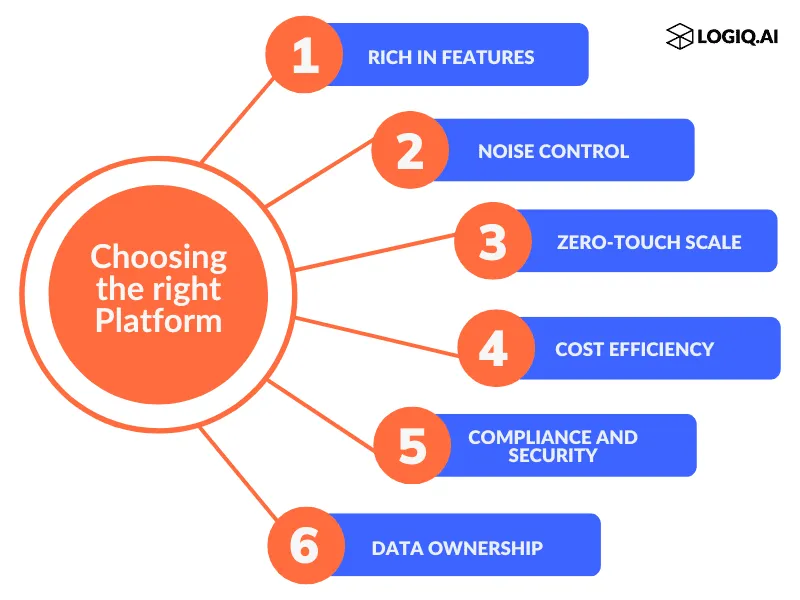According to a recent global survey conducted by Dimensional Research, 96% of respondents are experiencing a surge in log data. The survey also highlights that 79% of the respondents believe that the cost of observability and log management would considerably increase unless existing tools are updated.
The significance of Log management is undisputed, as businesses use metrics, logs, and traces to detect, diagnose, and isolate issues in their systems. However, similar to other IT-related aspects, Log management solutions are constantly developing and evolving swiftly.
Logs are an essential part of every organization’s infrastructure, as they contain valuable information that can be used to optimize system performance, detect and diagnose issues, and provide insights into user behavior.
Moreover, Logs are the final source of truth for your organization. It is critical to get the decision-making criteria right to avoid a painful and low ROI experience after making the decision.
However, managing logs can be a daunting task, particularly when you have a large volume of data coming from multiple sources. This is where log management solutions like apica.io come in.
Apica provides a centralized platform for collecting, storing, and analyzing logs. But how do you choose the right solution for your organization? In this post, we will explore some key decision-making criteria that you should consider when evaluating log management solutions.

1. Rich in Features
One of the primary criteria that you should consider when evaluating log management solutions is the range of features that they offer. Look for a solution that has features such as log aggregation, query-based searches, alerting capabilities, and integration with other tools.
Some Key capabilities that your log management software must provide include the following:
- Ease of data collection – It should be easy to collect data with minimal configuration. If the software allows you to use existing data collectors like fluentd, logstash, syslog, fluent-bit it data collection becomes a breeze.
- Diverse log source support – There should be support for logs of all sources like apps, infrastructure components, network devices, APIs, public cloud infrastructure and services. The software should support on-premises and public cloud components alike.
- AI/ML – To ensure rapid root cause analysis and identification of opportunities, the software must support AI/ML-powered pattern recognition and error and anomaly detection.
- Search, Reports, Dashboards, Scheduling, and Analytics – There should be rich support for search combinations of all types, reports for all types of data, dashboards to present the data in a layout that is easy to understand, scheduling of reports and analytics to surface the right data at the right time.
- Easy retention of data – Depending on your industry you may need to retain data for months or even years. The software should not require additional management of archiving data and then rehydrating data causing productivity loss and most importantly delays in gathering insights.
- Alerts and Notifications – It should be possible for you to configure alerts to your preferred alert destinations but not limited to e-mail, Slack, ServiceNow, etc.
2. Noise Control
Logs are semi-structured, voluminous, and noisy. This means that it is essential to eliminate noise, as it can consume your licensing dollars, increase your time to resolve issues, and waste your valuable infra dollars if the software is self-hosted.
When evaluating log management solutions, look for software that allows for manual and intelligent identification of noise and provides easy removal of it before processing.
Noise in log data refers to the amount of zero or low-value data that yields no valuable insights for you but consumes your precious licensing dollars, increases your time to resolve issues, and wastes your valuable infra dollars if the software is self-hosted.
3. Zero-touch scale, near-real-time speed, and Low Cost
Solving the elusive trifecta of high scale, near-real-time speed, and low cost is an important decision-making criterion.
Additionally, It is important for you to choose a log management software that provides all of the 3 and not any two of them. Most of the software available in the market today forces you into the difficult choice of any 2 of the three as they do not provide all the 3 benefits.
As a user, look for software that can support:
- Hundreds of TBs of log data per day
- Provide querying and reporting times that are instantaneous
- Cost you pennies and not dollars per GB/host
4. Cost Efficiency
Another key criterion is cost efficiency. Be sure to compare the cost of different solutions in terms of their features and scalability to ensure that you’re getting value for money. Consider also if there are any discounts for volume purchases, or if the solution offers a free trial to test it out before committing.
In addition, consider the cost of operational use. Some analytics solutions require a substantial amount of manual labor to maintain and configure while others are automated and require very little support. Make sure to factor in these costs when making your decision.
Finally, you should also look at the total cost of ownership (TCO) for any solution that you’re considering. TCO takes into account not only the initial cost of the solution but also any additional costs associated with scalability and support over time. This will ensure that you are making a sound financial decision when selecting an analytics solution
5. Compliance and Security
Compliance and security play a key role in the decision-making process for selecting the right log management software.
In an increasingly regulated climate, it is important to have two key capabilities.
- Mask sensitive data – The software must provide a way for you to manually and intelligently mask sensitive data like PII and PHI to ensure that it does not sit at rest and make your organization non-compliant inviting very expensive fines.
- Quick compliance data search and reporting – Traditionally, searching and reporting on compliance data has been a time-consuming process. It is because organizations find it expensive to store compliance data as part of their primary hot tier and so push data to a cold and inexpensive tier. This results in very slow retrieval, rehydration, and reporting times, in that order.
It is important for you to choose software that allows both fast and inexpensive indexing on scalable and low-cost storage like object storage. This ensures that compliance will be both fast and inexpensive for your organization.
6. Data Ownership
It is critical to own and be in control of your data. While the security of data transfer is guaranteed by almost every vendor in the market, very few allow you to own your data.
Note that data is the lifeblood of the organization and logs (after all the noise has been removed) contain very important information. It is important for the software vendor to provide two key capabilities.
1. Data is stored in an open and non-proprietary format. This is important because long after you decide to stop using the log management software it should be possible for you to read, query, analyze and report on your own data. That will not be possible if the data is locked into the vendor’s own format.
2. Data storage in your cloud account or data center. It might also be important that your data does not leave your environment. So it is important for the vendor to provide a self-hosted option for the entire log management stack or at least the data storage tier as a hybrid PaaS-SaaS model with the data in your control while the compute happens at the vendor’s cloud.
Conclusion
By considering the aforementioned criteria when selecting a log management solution, you can be sure that you’re getting the right tool for your business’s needs. With the right solution in place, logging and monitoring will be easier and more efficient than ever before.
In conclusion, when making decisions related to data management and processing, it is important to consider key criteria such as feature-richness, noise control and elimination, scalability, speed, cost-effectiveness, compliance, security, and data ownership. These factors are essential in ensuring that data is handled efficiently and effectively.
With apica.io, you can rest assured that your data management needs will be met in line with these criteria, and more. Our platform provides a range of features such as advanced analytics, extensive log management, real-time monitoring, and more. What’s more, is that our solution ensures complete data security with end-to-end encryption.
In addition to that, Apica provides secure storage for all your audit logs and other records to ensure compliance with data privacy regulations; empowering you to take control of your data.
Apica also offers an easy-to-use interface that allows you to maximize performance, scalability, and efficiency while eliminating the need for manual processes. Our platform is built on a distributed architecture that ensures high availability and reliable performance no matter the amount of data or the size of your organization.
In a Glimpse
- Log Management Solutions are constantly evolving, and it is critical to make the right decision when choosing one.
- Look for a platform with features such as log aggregation, query-based searches, alerting capabilities, and integration with other tools.
- Consider ease of data collection, diverse log source support, AI/ML-powered pattern recognition, and analytics when evaluating solutions. Eliminating noise from the logs is important to maximize licensing dollars and minimize wasted resources.
- Zero-touch scale, near real-time speed, and low cost are important decision-making criteria.
- Cost efficiency should also be taken into consideration when comparing different solutions.
- Compliance and security are key criteria – look for manual and intelligent identification of noise and data masking capabilities.
- Ownership of the data should be ensured by using an open format, giving control to the user.
- Apica provides advanced analytics, extensive log management, real-time monitoring for reliable performance with secure storage ensuring compliance with regulations.











